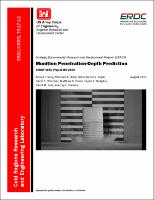Please use this identifier to cite or link to this item:
https://hdl.handle.net/11681/22905Full metadata record
| DC Field | Value | Language |
|---|---|---|
| dc.contributor.author | Song, Arnold J. | - |
| dc.contributor.author | West, Brendan A. | - |
| dc.contributor.author | Taylor, Oliver-Denzil S. | - |
| dc.contributor.author | O’Connor, Devin T. | - |
| dc.contributor.author | Parno, Matthew D. | - |
| dc.contributor.author | Hodgdon, Taylor S. | - |
| dc.contributor.author | Cole, David M. | - |
| dc.contributor.author | Clausen, Jay L. | - |
| dc.date.accessioned | 2017-09-06T16:08:20Z | - |
| dc.date.available | 2017-09-06T16:08:20Z | - |
| dc.date.issued | 2017-08 | - |
| dc.identifier.uri | http://hdl.handle.net/11681/22905 | - |
| dc.identifier.uri | http://dx.doi.org/10.21079/11681/22905 | - |
| dc.description.abstract | Existing models for predicting the penetration depth of munitions and explosives of concern are inaccurate and insufficient from a user (range manager, U.S. Army Corps of Engineers project manager, or environmental consultant) operability perspective for current needs. We attribute poor model performance to (1) a heavy dependence on empirically derived parameterizations poorly linked to the physical properties of the target material or (2) physics-based models that inadequately capture the salient mechanical processes, especially in the first meter of penetration. Consequently, we have developed a micromechanical-based model using a hybrid discrete element model (DEM) / finite element model (FEM) approach capable of a detailed treatment of near-surface soil properties. To examine the effects of varying levels of moisture on the dynamic behavior of a soil, we fabricated a small-scale triaxial shear test to inform the development and calibration of the DEM contact model. We conducted projectile-drop tests into sand with a scale version of a 57 mm projectile and measured projectile penetration to compare with model results. | en_US |
| dc.description.sponsorship | Strategic Environmental Research and Development Program (U.S.) | en_US |
| dc.language.iso | en | en_US |
| dc.publisher | Cold Regions Research and Engineering Laboratory (U.S.) | en_US |
| dc.publisher | Engineer Research and Development Center (U.S.) | en_US |
| dc.relation.ispartofseries | ERDC/CRREL;TR-17-12 | - |
| dc.subject | Discrete element method | en_US |
| dc.subject | Finite element method | en_US |
| dc.subject | Numerical analysis | en_US |
| dc.subject | Projectiles | en_US |
| dc.subject | Penetration mechanics | en_US |
| dc.subject | Prediction | en_US |
| dc.subject | Soils | en_US |
| dc.title | Munition penetration-depth prediction : SERDP SEED Project MR-2629 | en_US |
| dc.type | Report | en_US |
| Appears in Collections: | Technical Report | |
Files in This Item:
| File | Description | Size | Format | |
|---|---|---|---|---|
| ERDC-CRREL TR-17-12.pdf | 1.91 MB | Adobe PDF |  View/Open |